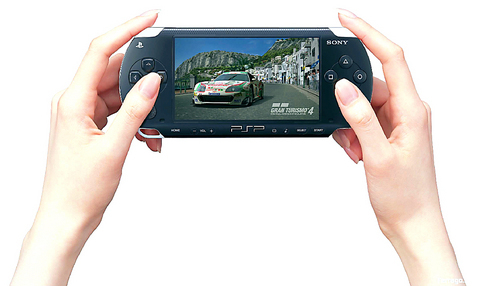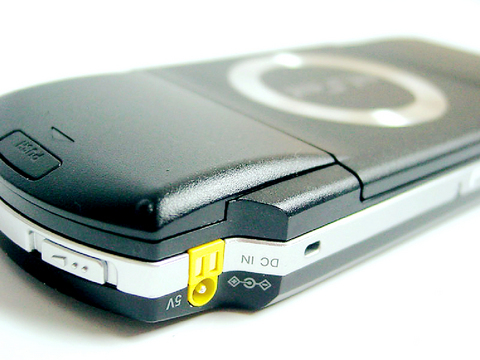I'm not a gamer and haven't bothered playing one since trying, and failing, to clear the third screen of Ms. Pac Man. That said, Sony's new PSP, or Play Station Portable, might be cool enough to convert even game-hating grinches like me.
If not for the fun of the games themselves, then for the fact that the PSP plays movies and music, can present your photos in slide-show fashion and connects to other PSPs via wireless Wi-Fi. That last feature also gives it the potential to do a lot more. Rumors on the Web say it will eventually be able to download music and possibly be used as a telephone via VoIP, or Voice Over Internet Protocol -- rumors that Sony has done nothing to squelch.
The problem with the PSP, however, is the same one that plagues so many other Sony products and makes the company the hegemon of high-tech hardware manufacturers: proprietary formatting. Yes, you can watch a movie on the PSP. But it had better be stored on a Universal Media Disk, or UMD, a format the company created that resembles a Mini-Disk and which is anything but "universal."

PHOTO COURTESY OF SONY
I wonder how many of the Chinese youths who recently took to the streets in anger at Japan were actually upset about ATRAC, Sony's proprietary digital music format. Now another new format? Sony, it would seem, needs to "face up to its history" and "have deep and profound reflections" on the issue if it wishes to be an industry leader.
Youths in Taiwan, however, seem unperturbed. To test drive a PSP -- literally, playing Ridge Racer -- I had to elbow into a mob of a different kind gathered around a demo model at a store in Taipei's Guanghua Market. If the reaction of that crowd is any indication, the PSP will enjoy here the same kind of sales it has had in the US since its release there last month, moving more than a half million units in its first two days on store shelves, generating over US$150 million in first-week sales and
setting an industry record.

PHOTO COURTESY OF SONY
It has enjoyed hype that started early last year as the most anticipated product of this year and hasn't disappointed consumers who have gotten their hands on a model. CNN's Porter Anderson, in a review of the device, even predicted that it will be ensconced in the New York Museum of Modern Art's collection of iconic everyday items, alongside Apple's iPod.
What!? The PSP is out barely a month and already being compared to an iPod? I didn't believe the hype until I elbowed the demo device away from a group of high school boys.
Hold it and you understand. It quite literally puts the action in your hands, in a sleek design that feels solid-state. A gift tossed to earth by the gaming gods, meant to occupy adolescent boys who might otherwise take up smoking. And with a screen that demands to be looked at, stared at.
That screen is a 4.3-inch TFT LCD display with a 16:9 wide-screen aspect ratio. It displays over 16 million colors in 480 x 272 pixel resolution. That would be clear enough to see the sweat dripping off the faces of Nintendo executives, whose own portable gaming device has only 256 x192 pixel resolution and 260,000 colors.
Here's the problem with that screen: In order to watch a movie that isn't on a UMD, you need to connect the PSP to your computer via USB (the PSP is equipped with a USB port, but doesn't ship with a USB cable, for reasons that become clear when you get it out of the box). Drag and drop the music files from your computer to the PSP's flash media card (The PSP ships with a 32MB card, but you'll need a bigger one for storing movies) then create a ROOT_MP directory on the memory card and use a combination of image
converters to change the file into something more PSP-palatable. A US$10 image converter is among the many things Sony says is in the PSP pipeline.
Why the hassle? Sony would rather you stick to buying video content on their UMD format, of course, which they've priced the same as DVDs.
Listening to music is easier. And the fact that the PSP will play more than just Sony's ATRAC files is a relief. Just drag and drop your music from your computer to the PSP via USB cable and it shows up on the device. However, that's about the limit of the PSP's music-playing capabilities; no operable equalizer, no bells and whistles and, worst of all, no listening to Judas Priest's Turbo Lover and playing Ridge Runner at the same time. Equally abhorrent is the lack of volume you get from music files. Games play at a louder volume than music.
Sony says the PSP has up to five-and-a-half hours of battery life and Internet-based reviews support this claim. What's more, the company has outfitted the device with lithium-ion batteries that can be swapped out (if you have another battery), eliminating the need to plug in the device to charge it.
What may eventually be really cool is the "so much more" that Sony says the PSP is (read: may become). Much of this centers on the device's Wi-Fi capability. Currently, the PSP is only set up to game with other PSPs over a local wireless network, but already the device has been hacked to surf the Internet. The next logical step is for Sony to use this wireless capability for firmware upgrades or downloading music from their online music store Label Gate, or any number of other applications.
The hardware is there for the device to do a lot and even find an audience outside the gaming community. What remains to be seen is what direction Sony will take it.
Bottom line: Unless you're among the gotta-have-it crowd, hold onto your game tokens for the upgrade.

May 26 to June 1 When the Qing Dynasty first took control over many parts of Taiwan in 1684, it roughly continued the Kingdom of Tungning’s administrative borders (see below), setting up one prefecture and three counties. The actual area of control covered today’s Chiayi, Tainan and Kaohsiung. The administrative center was in Taiwan Prefecture, in today’s Tainan. But as Han settlement expanded and due to rebellions and other international incidents, the administrative units became more complex. By the time Taiwan became a province of the Qing in 1887, there were three prefectures, eleven counties, three subprefectures and one directly-administered prefecture, with

It’s an enormous dome of colorful glass, something between the Sistine Chapel and a Marc Chagall fresco. And yet, it’s just a subway station. Formosa Boulevard is the heart of Kaohsiung’s mass transit system. In metro terms, it’s modest: the only transfer station in a network with just two lines. But it’s a landmark nonetheless: a civic space that serves as much more than a point of transit. On a hot Sunday, the corridors and vast halls are filled with a market selling everything from second-hand clothes to toys and house decorations. It’s just one of the many events the station hosts,

Among Thailand’s Chinese Nationalist Party (KMT) villages, a certain rivalry exists between Arunothai, the largest of these villages, and Mae Salong, which is currently the most prosperous. Historically, the rivalry stems from a split in KMT military factions in the early 1960s, which divided command and opium territories after Chiang Kai-shek (蔣介石) cut off open support in 1961 due to international pressure (see part two, “The KMT opium lords of the Golden Triangle,” on May 20). But today this rivalry manifests as a different kind of split, with Arunothai leading a pro-China faction and Mae Salong staunchly aligned to Taiwan.

Two moves show Taichung Mayor Lu Shiow-yen (盧秀燕) is gunning for Chinese Nationalist Party (KMT) party chair and the 2028 presidential election. Technically, these are not yet “officially” official, but by the rules of Taiwan politics, she is now on the dance floor. Earlier this month Lu confirmed in an interview in Japan’s Nikkei that she was considering running for KMT chair. This is not new news, but according to reports from her camp she previously was still considering the case for and against running. By choosing a respected, international news outlet, she declared it to the world. While the outside world